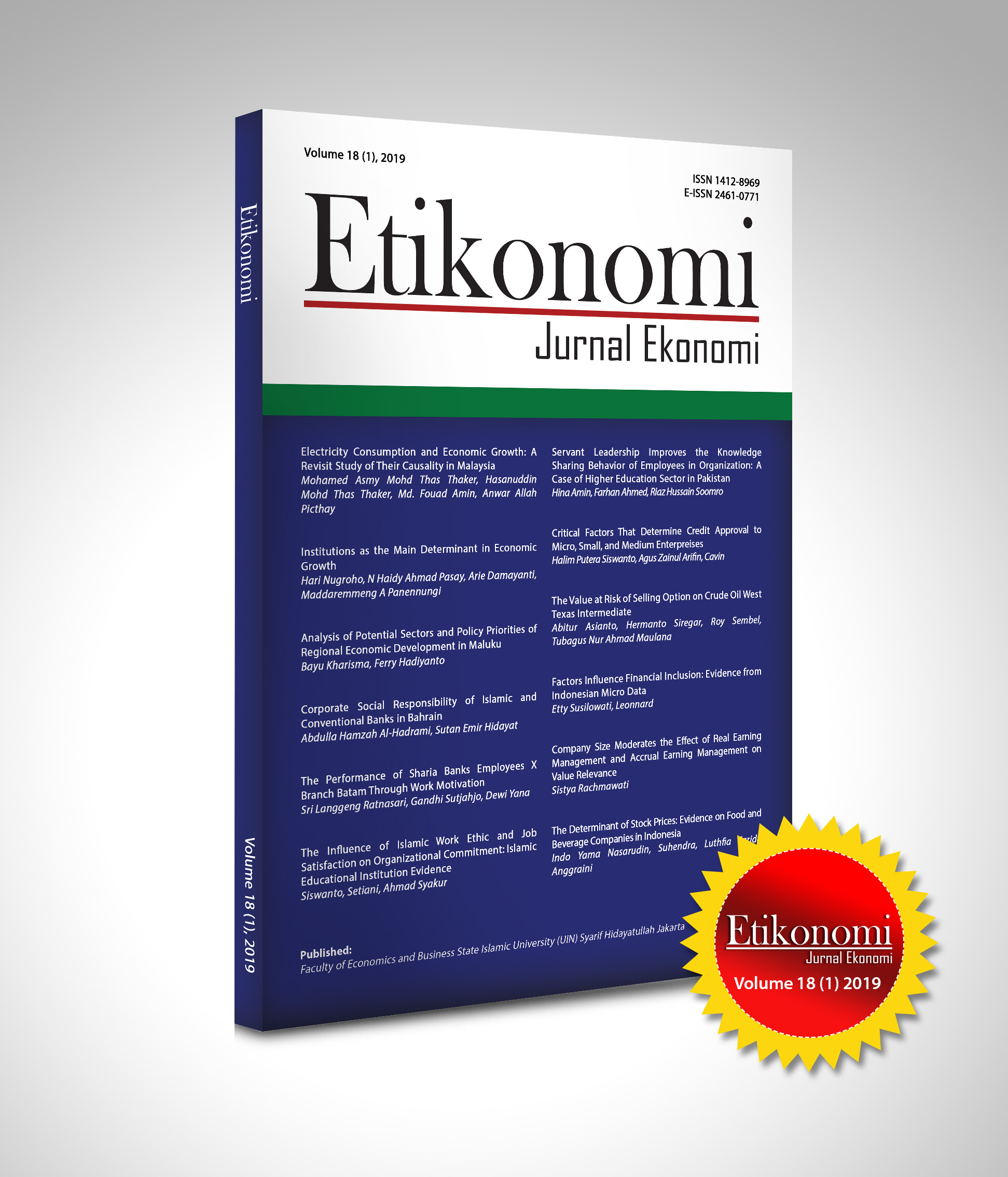Analysis of Potential Sectors and Policy Priorities of Regional Economic Development in Maluku Province
DOI:
https://doi.org/10.15408/etk.v18i1.7440Keywords:
Regional Economic Development in Maluku Province, Location Quotient (LQ), Growth Ratio Model (MRP), Overlay Analysis, Analytic Network Procecss (ANP), Infrastructure PolicyAbstract
The development policy in Maluku Province cannot separate from the small islands that dominate the areas. Its central potentials are in the field of fisheries, agriculture, and mining. This research aims to analyze the potentials of the leading sector and to formulate policy priorities for regional development in Maluku Province. The research used in this research is Location Quotient (LQ), Growth-Ratio Model (MRP), Overlay, SWOT and Analytic Network Process (ANP). The results showed that in Maluku Province there are eight economic categories that have base sectors. The result of Growth-Ratio Model (MRP) shows that the sector with the highest average the ratio of growth in the study area (RPs) is mining and quarrying sector. Furthermore, Overlay analysis shows that government administration, defense, social security sectors are obliged to contribute to and the highest growth. The result of SWOT-ANP shows that policy priority in regional development is the acceleration of infrastructure development.
JEL Classification: E01, H70, R11
Downloads
References
Adhitama, R. (2012). Pengembangan Sektor-Sektor Ekonomi di Tiap Kecamatan di Kabupaten Magelang (Development of Economic Sectors in Each District in Magelang District). Economics Development Analysis Journal, 1(2), 1–9.
Adisasmita, R. (2005). Dasar-Dasar Ekonomi Wilayah (The Fundamental of Regional Economic). Yogyakarta: Graha Ilmu.
Ariyasa, I. B. W. (2009). Identifikasi Sektor atau Subsektor Potensial untuk Menentukan Prioritas Pembangunan di Kabupaten Gianyar Provinsi Bali (Sector Identification or Potential Subsector to Determine Development Priorities in Gianyar Regency, Bali Province). Denpasar: Universitas Udayana.
Arsic, S., Mihajlovic, I. N., & Fedajev, A. (2018). Approach Within ANP-SWOT Framework for Prioritization of Ecosystem Management and Case Study of National Park Djerdap, Serbia. Ecological Economics Journal, 146, 85–95. https://doi.org/10.1016/j.ecolecon.2017.10.006
Arsyad, L. (1999). Pengantar Perencanaan dan Pembangunan Ekonomi Daerah (Introduction to Regional Economic Planning and Development). Yogyakarta: BPFE UGM.
Aswandi, H., & Kuncoro, M. (2002). Evaluasi Penetapan Kawasan Andalan : Studi Empiris di Kalimatan Selatan 1993-1999 (Evaluation of Mainstay Area Determination: Empirical Study in South Kalimantan 1993-1999). Jurnal Ekonomi Dan Bisnis, 17(1), 27–45.
Azimi, R., Yazdani-Chamzini, A., Fouladgar, M. M., Zavadskas, E. K., & Basiri, M. H. (2011). Ranking the Strategies of Mining Sector Through ANP and TOPSIS in a SWOT Framework. Journal of Business Economics and Management, 12(4), 670–689.
Basuki, T. A., & Gayatri, U. (2009). Penentuan Sektor Unggulan dalam Pembangunan Daerah : Studi kasus di Kabupaten Ogan Komering Ilir (Determination of Leading Sectors in Regional Development: Case study in Ogan Komering Ilir Regency). Jurnal Ekonomi Dan Studi Pembangunan, 10(1), 34–50.
Bendavid-Val, A. (1991). Regional and Local Economic Analysis for Practitioner (Fourth). California: Sage Publication.
Chung, S. H., Lee, A. H. L., & Pearn, W. L. (2005). Analytic Network Process (ANP) Approach For Product Mix Planning in Semiconductor Fabricator. International Journal of Production Economics, 96(1), 15–36.
Gunawan, M. W. (2011). No TitleAnalisis Sektor-Sektor Unggulan Perekonomian Kabupaten Rembang tahun 2000-2008 (Analysis of the Leading Sectors of the Rembang Regency Economy in 2000-2008). (Unpublished Thesis). Bogor: Institut Pertanian Bogor.
Kalalimbong, A. (2010). Kajian Infrastruktur di Provinsi Maluku (Infrastructure Study in Maluku Province). Jurnal Teknologi, 7(1), 751–758.
Kuncoro, M. (2004). Otonomi dan Pembangunan Daerah (Autonomy and Regional Development). Jakarta: Erlangga.
Latuny, E. M. (2014). Analisis Sektor Unggulan di Provinsi Maluku (Leading Sector Analysis in Maluku Province). Jurnal Cita Ekonomika, 8(2), 148–157.
Legendre, P. (2005). Species Associations: The Kendall Coefficient of Concordance Revisited. Society Journal of Agricultural, Biological, and Environmental Statistics, 10(2), 226–245.
Marlina, Y. (2014). Analisis Sektor Unggulan Dalam Perekonomian Kota Bogor 2006-2012 (Leading Sector Analysis in the Economy of Bogor City 2006-2012). (Unpublished Thesis). Bogor: Institut Pertanian Bogor.
Saaty, T. L. (2005). Theory and Applications of the Analytic Network Process: Decision Making with Benefits, Opportunities, Costs, and Risks. Pittsburgh: RWS Publications.
Saaty, T. L. (2008). Decision Making With The Analytic Hierarchy Process. International Journal Services Sciences, 1(1), 83–98.
Saaty, T. L., & Vargas, L. G. (2006). Decision Making with the Analytic Network Process : Economic, Political, Social and Technological Applications with Benefits, Opportunities, Costs, and Risks (2nd editio). Pittsburgh: Springer.
Setyorini, G. D., & Gunawan, R. S. (2008). Identifikasi Pengembangan Wilayah Kabupaten Anggota Lembaga Regional Barlingmascakeb (Identification of Regional Development of Regency Members of the Barlingmascakeb Regional Institution). Jurnal Ekonomi Dan Studi Pembangunan, 9(1), 26–43.
Tanjung, H., & Devi, A. (2013). Metodologi Penelitian Ekonomi Islam (Islamic Economic Research Methodology). Bekasi: Gramata Publishing.
Tarigan, R. (2005). Ekonomi Regional : Teori dan Aplikasi (Regional Economics : Theory and Applications). Jakarta: Bumi Aksara.
Yüksel, I., & Dagdeviren, M. (2007). Using The Analytic Network Process (ANP) in A SWOT Analysis : A Case Study For A Textile Firm. Information Sciences, 177(16), 3364–3382.
Yusuf, M. (1999). Model Rasio Pertumbuhan (MRP) sebagai Salah Satu Alat Analisis Alternatif dalam Perencanaan Wilayah dan Kota: Aplikasi Model Wilayah Bangka‐Belitung (Growth Ratio Model (MRP) as One Alternative Analysis Tool in Urban and Regional Planning: Bangka-Belitung. Ekonomi Dan Keuangan Indonesia, XLVII(2), 219–233.










